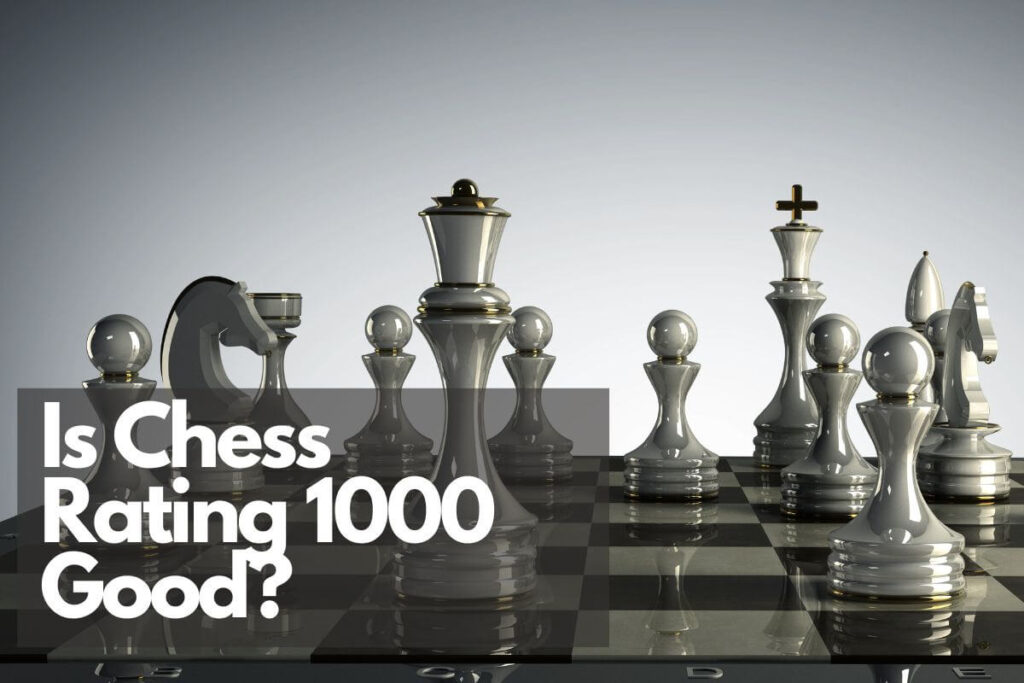A chess rating of 1000 is often a starting point for many players and is generally considered to be at a beginner level. Let’s explore this rating in more detail.
Significance of a 1000 Chess Rating
On platforms like chess.com, a rating of 1000 is described as a “great first step” and better than the average, which is around 50 percent of chess players.
It’s important to note that 1000-1500 is considered a beginner level, while a rating of 1500 is better than 90-95% of all players. This indicates that a rating of 1000 places a player in the early stages of their chess journey.
Community Perception
In a Reddit discussion, a 1000 rating is referred to as a beginner ranking. It is suggested that this rating may indicate making significant mistakes during games.
However, it’s also noted that making such mistakes is not uncommon, especially in shorter time controls. This further emphasizes that a rating of 1000 is associated with a learning phase in the game.

How to achieve a 1000 chess rating as a complete beginner?
To achieve a 1000 chess rating, several strategies can be employed to improve one’s game and rating. Here are some insights gathered from the chess community:
Emphasis on Tactics
- Practice Tactics: Engaging in regular tactical training is essential. Solving chess tactics problems daily can help improve tactical pattern knowledge and enhance board vision
Opening Repertoire and Game Analysis
- Learn Basic Openings: Focusing on a few basic openings for both white and black pieces can provide a solid foundation for the early game
- Analyze Grandmaster Games: Studying games played by grandmasters can offer valuable insights into strategic and tactical aspects of chess
Continuous Learning and Improvement
- Seek Educational Resources: Reading books on the history of chess and the lives of world champions can foster a deeper understanding and appreciation for the game
- Utilize Online Resources: Watching educational chess videos and joining chess clubs or communities can provide additional learning opportunities
Realistic Expectations
- Dedication and Patience: It’s important to recognize that progress may take time, and consistent dedication to improvement is key
- Average Attainability: While opinions vary, it’s generally considered achievable for an average adult to reach a 1000 rating with commitment and ongoing practice
By focusing on these strategies and maintaining a dedicated approach to learning and playing, individuals can work towards achieving a 1000 chess rating and continue to progress in their chess journey.
What is the history of chess rating?
The first modern chess rating system was used by the Correspondence Chess League of America in 1939.
Soviet player Andrey Khachaturov proposed a similar system in 1946. The first one that made an impact on international chess was the Ingo system in 1948. The USCF adopted the Harkness system in 1950.
The Elo rating system, named after its creator Arpad Elo, was officially adopted by the US Chess Federation in 1960 and by FIDE in 1970.
It is currently the most widely used rating system in chess. Other rating systems include the Chessmetrics system, which is based on computer analysis of a large database of games, and the Universal Rating System, which was developed by Mark Glickman, Jeff Sonas, J. Isaac Miller, and Maxime Rischard.
Most rating systems are used to recalculate ratings after a tournament or match, and a higher number indicates a stronger player.
Players’ ratings go up if they perform better than expected and down if they perform worse than expected, with the magnitude of the change depending on the rating of their opponents.
What are the different types of chess rating systems?
There are several types of chess rating systems, each with its own methodology and purpose. Some of the notable chess rating systems include:
- Elo rating system: Developed by Arpad Elo, this system is currently the most widely used rating system in chess. It is known for its simplicity and effectiveness in estimating players’ strengths
- Ingo system: Introduced in 1948, the Ingo system made a significant impact on international chess. It was the first rating system that gained global recognition
- Harkness system: Devised by Kenneth Harkness in the mid-twentieth century, this system was used by the USCF and several other international chess organizations from 1950 until 1960
- Glicko rating system: Formulated by Mark E. Glickman, this system made changes to the existing Elo rating system to improve its accuracy
- Chessmetrics system: Developed by Jeff Sonas, this system is based on computer analysis of a large database of games and is intended to be more accurate than other rating systems. It has received some criticism for relying solely on calculations rather than the quality of a chess game played
- Universal Rating System: Developed by Mark Glickman, Jeff Sonas, J. Isaac Miller, and Maxime Rischard, this system was designed to be more inclusive and accurate than other rating systems
These rating systems share the common goal of estimating players’ strengths and providing a fair and accurate basis for organizing and conducting chess tournaments.
They differ in their methodologies, with some systems focusing on simplicity and others on complexity and computational power
Conclusion
In summary, while a rating of 1000 demonstrates an understanding of the game’s rules and basic strategies, it is still considered a beginner level in the context of chess.
It represents a starting point for many players, and as they gain experience and improve their skills, they can progress to higher ratings and levels of play.


